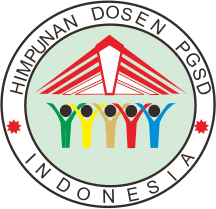Analisis kesulitan peserta didik dalam menyelesaikan soal numerasi pecahan pada Asesmen Kompetensi Minimum di sekolah dasar
Abstract
Keywords
Full Text:
PDFReferences
Iman, N., Usman, N., & Bahrun. (2021). Implementasi Kebijakan Sekolah Dasar dalam Menghadapi Asesmen Kompetensi Minimum. Jurnal Pendidikan: Teori, Penelitian, dan Pengembangan, 6(No. 2 Bulan Februari Tahun 2021), 250–260. [2] Kemendikbud. (2020). AKM dan Implikasinya pada Pembelajaran. In Pusat Asesmen Dan Pembelajaran Badan Penelitian Dan Pengembangan Dan Perbukuan Kementerian Pendidikan Dan Kebudayaan Pembelajaran Badan Penelitian Dan Pengembangan Dan Perbukuan Kementerian Pendidikan Dan Kebudayaan. [3] Mahmud, M. R., & Pratiwi, I. M. (2019). Literasi Numerasi Siswa Dalam Pemecahan Masalah Tidak Terstruktur. KALAMATIKA Jurnal Pendidikan Matematika, 4(1), 69–88. https://doi.org/10.22236/kalamatika.vol4no1.2019pp69-88 [4] OECD. (2019). PISA 2018 Assessment and Analytical Framework. In OECD Report. 1–38. https://doi.org/https://doi.org/10.1787/b25efab8-en. IS [5] Sari, V. P., Marlina, T., & Marlina, L. (2022). Analisis Kesulitan Peserta Didik Dalam Menyelesaikan Soal Cerita Kelas Rendah. Al-Madrasah: Jurnal Pendidikan Madrasah Ibtidaiyah, 6(3), 535. https://doi.org/10.35931/am.v6i3.1020 [6] Wahyuningsih, S. (2021). Modul Literasi Numerasi Di Sekolah Dasar ( dan T. Kementerian Pendidikan, Kebudayaan, Riset (ed.)). Direktorat Jenderal Paud, Pendidikan Dasar, dan Pendidikan Menengah. [7] Netson, B. P. H., & Ain, S. Q. (2020). Factors Causing Difficulty in Learning Mathematics for Elementary School Students. International Journal of Elementary Education, 4(1), 130–138. [8] Mardiyanti, L., Magriati, D., & Ikrom, M. (2022). Analisis Kesulitan Siswa dalam Menyelesaikan Soal Matematika Kelas V SD Negeri 55 Lubuklinggau. 7(1), 1–14. [9] Miles, M. B., Huberman, A. M., & Saldana, J. (2014). Qualitative Data Analysis A Methods Sourcebook (III). SAGE Publications Ltd. [10] Matondang, A. R., Nasution, F. S., & Setiawati, N. A. (2021). Asesmen Kompetensi Minimum Merdeka Belajar ditinjau dari Perspektif Guru Sekolah Dasar. Mahesa Research Center, 1(1), 159–165. https://doi.org/10.34007/ppd.v1i1.185 [11] Pantiwati, Y., & Nyono, N. (2020). Asesmen Autentik dalam Kegiatan Praktik Pembelajaran sains. Prosiding Seminar Nasional Pendidikan Biologi V 2019, 385–392. [12] Arum, N., & Amir, N. F. (2019). Journal of Mathematics Education IMPROVING STUDENT LEARNING RESULTS THROUGH THE. Journal of Mathematics Education, 4(1), 8–13. https://doi.org/http://doi.org/10.31327/jomedu.v4i1.879 [13] Runtukahu dan Kandou. (2014). Pembelajaran Matematika Dasar Bagi Anak Berkesulitan Belajar. Ar-ruz Media. [14] Jamaris, M. (2015). Kesulitan Belajar: Perspektif, Asesmen, dan Penanggulangannya. Ghalia Indonesia. [15] Slameto. (2010). Belajar dan faktor-faktor yang Mempengaruhinya. PT Rineka Cipta. [16] Hasibuan, E. K. (2018). Analisis Kesulitan Belajar Matematika Siswa Pada Pokok Bahasan Bangun Ruang Sisi Datar Di Smp Negeri 12 Bandung. AXIOM : Jurnal Pendidikan dan Matematika, 7(1), 18–30. https://doi.org/10.30821/axiom.v7i1.1766 [17] Sahronih, S., Purwanto, A., & Sumantri, M. S. (2019). The effect of interactive learning media on students’ science learning outcomes. ACM International Conference Proceeding Series, Part F1483, 20–24. https://doi.org/10.1145/3323771.3323797 [18] Absah, Y., Karina, B., & Harahap, R. H. (2021). Strategies to Improve Student Satisfaction Through the Quality of Online Learning Facilities and Infrastructure, Characteristics of Academic Staff, Lecturers Competence, and Good University Governance in Medan. Systematic Reviews in Pharmacy, 12(03), 671–675.
Refbacks
- There are currently no refbacks.



